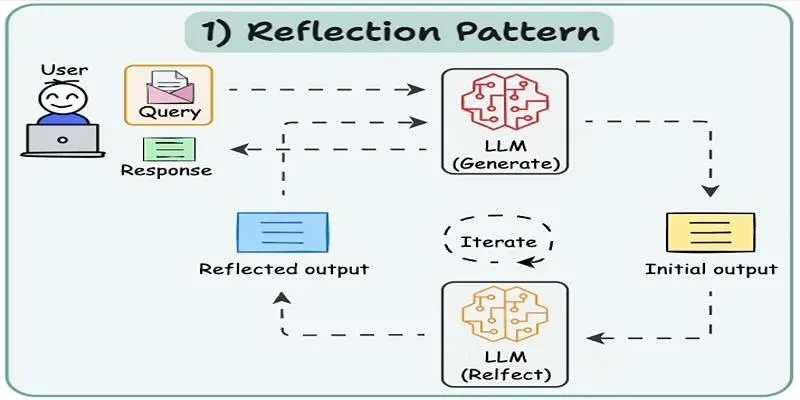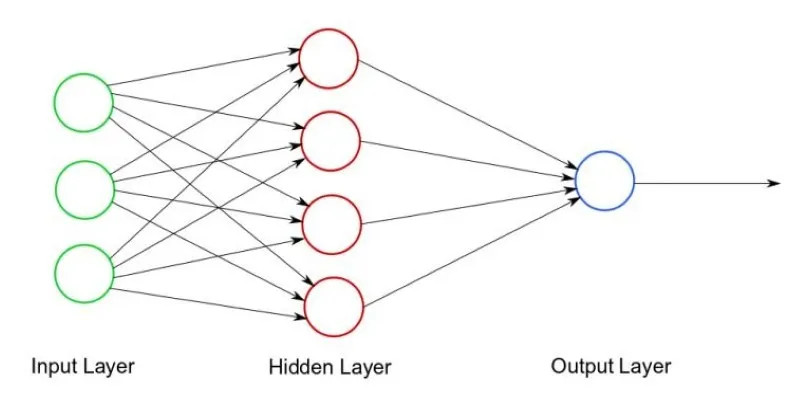Artificial Intelligence (AI) is entering a new era—an era where models evolve from mere tools providing single responses to dynamic systems capable of self- improvement. As AI systems become more sophisticated and autonomous, they require mechanisms to reflect on and refine their performance iteratively. One increasingly popular mechanism is the Agentic AI Reflection Pattern.
This design pattern allows AI models, particularly Large Language Models (LLMs), to evaluate and enhance their outputs through self-assessment. Much like humans revising an essay or rethinking a problem-solving approach, AI can reflect on its responses and improve them over several cycles. This article delves into the Agentic AI Reflection Pattern , explaining what it is, how it works, its components, and why it is vital for advanced AI applications.
Understanding the Reflection Pattern
The Reflection Pattern in agentic AI is a continuous process where an AI system generates content, evaluates its quality and accuracy, and refines it through subsequent iterations. This approach mimics human cognitive processes. Consider a course designer creating an online lesson: they draft, critically review, and revise until the lesson is polished and effective.
Similarly, an AI model using the Reflection Pattern improves its output through structured feedback loops. This iterative design is particularly valuable in contexts demanding accuracy, coherence, and completeness—such as summarizing academic papers, writing code, or generating detailed reports.
The Importance of the Reflection Pattern in Agentic AI
The Reflection Pattern’s core strength lies in its ability to progressively enhance AI-generated outputs. Instead of settling for a single response, it enables AI to act more intelligently by identifying flaws, critiquing them, and adapting accordingly.
Key Reasons for Its Importance:
- Improved Accuracy : Repeated evaluation allows AI to correct factual errors or misinterpretations.
- Greater Depth : Each iteration provides an opportunity to add relevant information or elaborate on vague areas.
- Context Awareness : Reflecting on previous outputs helps AI maintain and understand context more effectively.
- Autonomy : The pattern fosters agentic behavior, granting AI greater control over its learning and refinement process.
These features make the Reflection Pattern an ideal tool for Agentic AI, empowering AI agents to take responsibility for improving their performance.
Key Components of the Agentic AI Reflection Pattern

The Reflection Pattern consists of three main phases, forming a self- improvement loop:
1. Generation Step
The cycle begins with the initial generation of content in response to a prompt. This step, known as “zero-shot” prompting, involves the AI making its best attempt at answering a question, writing a paragraph, or solving a problem. While the result might be coherent and relevant, it often serves as a first draft lacking precision, depth, or complete accuracy.
2. Reflection Step
In this phase, the AI reviews its output as if it were a critic or evaluator, assessing:
- Factual correctness
- Logical flow
- Completeness
- Alignment with the original prompt
The AI then generates feedback or improvement suggestions, pointing out missing details, suggesting clearer phrasing, or recommending restructuring. This feedback guides the next iteration.
3. Iteration and Refinement
Using the critique from the reflection step, the AI creates a revised version of the original output. This improved content incorporates suggested changes and aims for higher quality. The generate → reflect → revise loop can continue for multiple iterations, stopping when a condition is met, such as a defined number of loops or reaching a quality threshold.
How the Reflection Pattern Works: A Step-by-Step Breakdown

Here’s a general step-by-step flow of the pattern:
- Prompt: The user inputs a prompt, e.g., “Summarize the main points of this climate change report.”
- Generate: The AI produces a summary, possibly covering general ideas but missing crucial details or statistics.
- Reflect: The AI identifies gaps, such as missing findings or unclear phrasing.
- Refine: The AI generates a revised summary, including the missing information and enhancing readability.
- Repeat: This cycle continues until the output meets the desired quality or a stopping condition is reached.
With each loop, the output becomes more accurate, coherent, and refined.
How the Reflection Pattern Strengthens Agentic AI
Agentic AI systems are defined by their ability to make autonomous decisions, learn from experience, and adapt strategies to achieve specific goals. The Reflection Pattern enhances this capability in several ways:
- Better Goal Alignment: The AI uses feedback to adjust its approach, improving its ability to meet task requirements.
- Learning from Mistakes: By identifying error patterns, the AI can avoid repeating them in the future.
- Meta-Cognition: The model gains the ability to “think about its thinking,” fostering a deeper understanding of its actions.
- Ethical Safeguards: Reflection can be programmed to ensure the AI’s actions align with ethical boundaries and safety guidelines.
These capabilities transform passive models into intelligent, evolving agents capable of real-time improvement.
Conclusion
The Agentic AI Reflection Pattern represents a significant evolution in designing and interacting with intelligent systems. It enables AI to generate content and evaluate, critique, and improve its work, moving closer to true autonomy. By mimicking the human learning process of revision and self- assessment, the Reflection Pattern ensures AI models deliver higher-quality outputs, reduce errors, and align more closely with user intent.
As AI continues to permeate creative, analytical, and decision-making roles, patterns like this will be crucial for unlocking its full potential. In the expanding realm of agentic AI, reflection is not just a feature—it’s a necessity.
 zfn9
zfn9





















